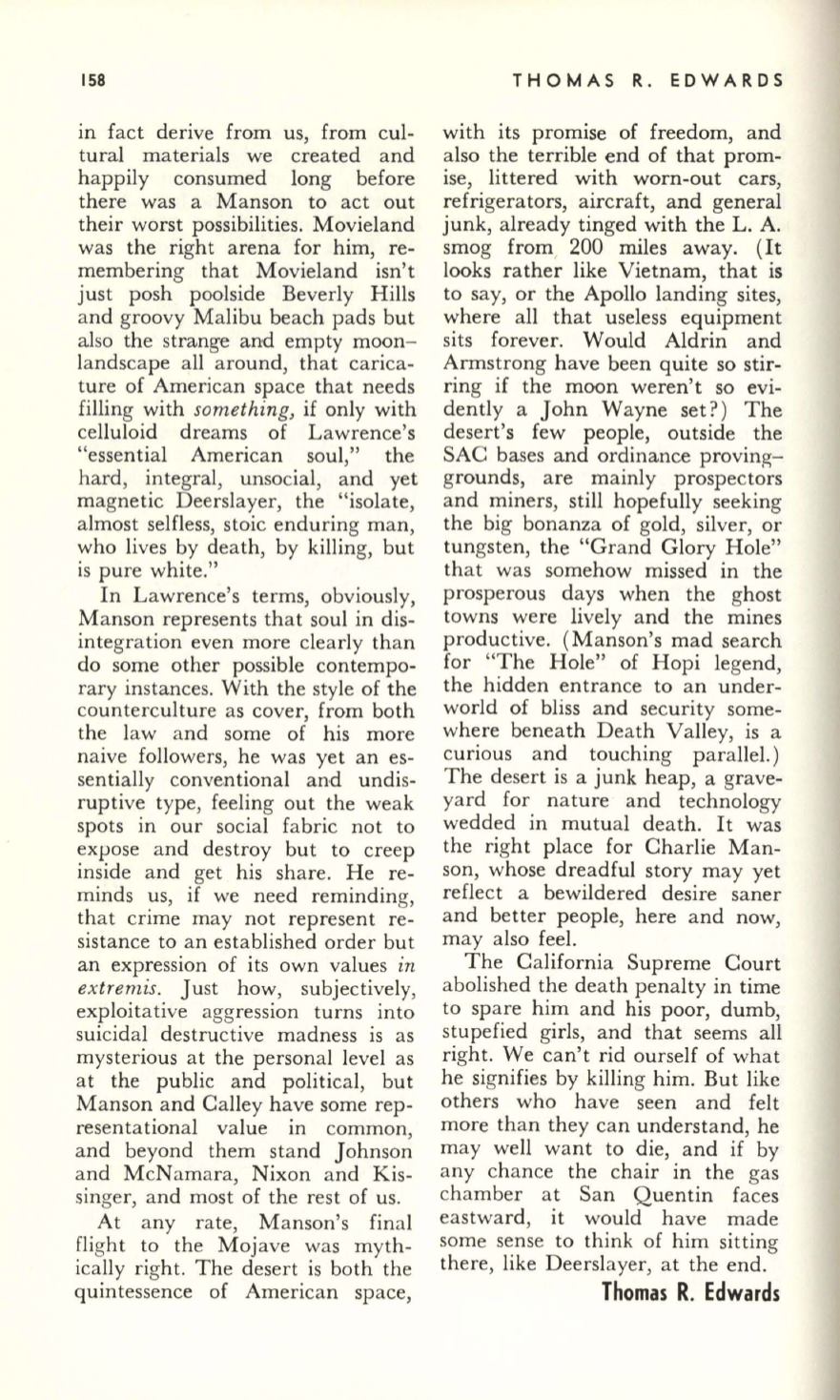
158
in fact derive from us, from cul–
tural materials we created and
happily consumed long before
there was a Manson to act out
their worst possibilities. Movieland
was the right arena for him, re–
membering that Movieland isn't
just posh poolside Beverly Hills
and groovy Malibu beach pads but
also the strange and empty moon–
landscape all around, that carica–
ture of American space that needs
filling with
something,
if only with
celluloid dreams of Lawrence's
"essential American soul," the
hard, integral, unsocial, and yet
magnetic Deerslayer, the "isolate,
almost selfless, stoic enduring man,
who lives by death, by killing, but
is pure white."
In Lawrence's terms, obviously,
Manson represents that soul in dis–
integration even more clearly than
do some other possible contempo–
rary instances. With the style of the
counterculture as cover, from both
the law and some of his more
naive followers, he was yet an es–
sentially conventional and undis–
ruptive type, feeling out the weak
spots in our social fabric not to
eXlJose and destroy but to creep
inside and get his share. He re–
minds us, if we need reminding,
that crime may not represent re–
sistance to an established order but
an expression of its own values
in
extremis.
Just how, subjectively,
exploitative aggression turns into
suicidal destructive madness is as
mysterious at the personal level as
at the public and political, but
Manson and Calley have some rep–
resentational value in common,
and beyond them stand Johnson
and McNamara, Nixon and Kis–
singer, and most of the rest of us.
At any rate, Manson's final
flight to the Mojave was myth–
ically right. The desert is both the
quintessence of American space,
THOMAS R. EDWARDS
with its promise of freedom, and
also the terrible end of that prom–
ise, littered with worn-out cars,
refrigerators, aircraft, and general
junk, already tinged with the
L.
A.
smog from 200 miles away.
(It
looks rather like Vietnam, that is
to say, or the Apollo landing sites,
where all that useless equipment
sits forever. Would Aldrin and
Armstrong have been quite so stir–
ring if the moon weren't so evi–
dently a John Wayne set?) The
desert's few people, outside the
SAC bases and ordinance proving–
grounds, are mainly prospectors
and miners, still hopefully seeking
the big bonanza of gold, silver, or
tungsten, the "Grand Glory Hole"
that was somehow missed in the
prosperous days when the ghost
towns were lively and the mines
productive. (Manson's mad search
for "The Hole" of Hopi legend,
the hidden entrance to an under–
world of bliss and security some–
where beneath Death Valley, is a
curious and touching parallel.)
The desert is a junk heap, a grave–
yard for nature and technology
wedded in mutual death.
It
was
the right place for Charlie Man–
son, whose dreadful story may yet
reflect a bewildered desire saner
and better people, here and now,
may also feel.
The California Supreme Court
abolished the death penalty in time
to spare him and his poor, dumb,
stupefied girls, and that seems all
right. We can't rid ourself of what
he signifies by killing him. But like
others who have seen and felt
more than they can understand, he
may well want to die, and if by
any chance the chair in the gas
chamber at San Quentin faces
eastward, it would have made
some sense to think of him sitting
there, like Deerslayer, at the end.
Thomas R. Edwards


